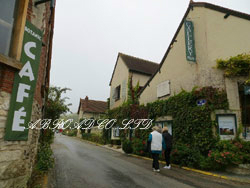biological and biosocial theories of crimehouses for rent wilmington, nc under $1000
biological and biosocial theories of crime
- フレンチスタイル 女性のフランス旅行をサポート
- 未分類
- biological and biosocial theories of crime
People in society reject the behaviour, and the individual ceases their deviant behaviour. theories on crime and punishment espoused by 18th-century European Enlightenment thinkers. If there is too much control, then people will be forced into conformity. Biosocial Theories in Criminology | Oxford Research WebMore information on contemporary biological and biosocial approaches . Studies show that interaction of Scientists don't know because they're afraid to ask, 10.1093/acprof:oso/9780199586073.001.0001, "Should We Be More Concerned With Prenatal Exposure in the Prevention Of Crime? In 1925, the social disorganization theory was introduced by two sociologists, Robert Shaw and Louis W. McKay. This is how people in society view criminal behaviour as it affects the identity of an individual. WebBiosocial criminology is an interdisciplinary field that aims to explain crime and antisocial behavior by exploring biocultural factors. Biosocial Criminology. Classical biological theories of criminality stated that people are "born criminals" who cannot be deterred from committing crimes: Whether due to mental or physical disability, criminals cannot learn to control themselves. In contrast, contemporary biological theories emphasize biosocial causes rather than strictly natural ones. What are the ecological consequences of a dead zone?Question 8Choose one of the ecosystems (e.g., montane, arctic tundra, tropical rainforest, etc.) [1] [2] Biosocial Theory also explains the shift from evolution to culture when it comes to gender and mate selection. Cesare Lombroso (18351909), the psychiatrist who was the father of criminal anthropology, marked indelibly the history and trajectory of biological explanations for criminal behaviour. [14], Once a crime's severity has been judged, there is a choice regarding how to respond. Robert Merton developed this theory in the 1930s. The social disorganization theory fails to clarify why people in poor neighborhoods do not always turn to crime as a way of making money to support themselves. Financially unstable people have a high chance of committing crimes because they can not fulfil their basic needs. Theories of Crime in Sociology- Explanations and Examples End of Preview - Want to read all 4 pages? While a man with an aggressive personality may be more likely to commit sexual violence than a woman, a man who grows up in poverty may be more likely to commit burglary than someone who does not have such an experience. The social element is important in explaining why levels of violence are higher in lower class areas. The stigmata do not cause the, Criminals also use a cost-benefit analysis to maximize their own rewards. Some crime types, such as white-collar crime and corporate crime, are improbable to be committed by individuals; these crimes require a certain amount of organization hence the irrationality. %PDF-1.7 % Using Akers theory, if one is able to gather statistical data of an area and take measures to make changes and improve that environment it could reduce the criminal presence in that area by disrupting the criminal element that exists. While contemporary criminology has been dominated by sociological theories, biosocial criminology also recognizes the potential contributions of fields such as behavioral genetics, neuropsychology, and evolutionary psychology. Therefore, a person who sees others committing crimes will be more likely to commit similar criminal acts. Honestly, I completely disagree with this theory and it has no ties to why Im not a criminal. Human Population Growth and the Environment, biology homework help. The classical theory has many criticisms, but perhaps the most important is that it cannot explain all types of crime. The idea behind labelling theory is that criminal behaviour is a result of social reaction. Some crimes have different causes than others. How were raptor species (e.g., peregrine, American kestrel) affected by biomagnification of the insecticide, DDT?Question 7What is a dead zone? WebThe basic principles of biological theories of crime are the idea that behavioral predispositions , including aggression and criminality , are constitutionally or physiologically influenced . 2019-11-14T13:13:12-08:00 It is therefore as a result that this author, has set out to investigate the implications that biological and biosocial theories have on the juvenile justice system. Beccaria argued that it is essential to prevent people from doing wrong and affecting others. This assumption changed when Lombroso discovered a few things about deviant people. The biosocial theories of crime investigate individual criminals to determine the root of their criminal habits. Early biological theories focused on how a person does not have free will because of their genetics and heredity. endobj The social element is important in explaining why levels of violence are higher in lower class areas. Theories of Crime Exam 1 Flashcards | Chegg.com A significant link between juvenile delinquency and testosterone levels has not been established. Biosocial In the past, it focused on getting more rights for women to work outside of their homes, but today many other issues need to be tackled. Biosocial Theories of Crime Beccaria believed that people could choose to commit crimes or not. Despite The The biological theories argue that the, behavior is beyond the control of an individual while engaging in some activities. How can we manage this ecosystem's homeostasis? The albino trait is recessiv a particle constrained to move in one dimension is subject to a force F(x) that varies with position x as F(x) = A sin(kx) 1. [3] Criminal justice researchers Brian Boutwell and J.C. Barnes argue that many sociological studies that do not control for genetic inheritance of risk factors have misleading or unreliable results. Several criminologists developed their own theories which explain why people commit crime, what makes them do it and also how we can prevent individuals from committing a crime again. Braithwaite, Thus, combining the rational-choice theory and the deterrence theory would form a better understanding of the causes of crime and crime prevention. Also, more crimes were registered when more black people started to move in. Poor people may believe they need to break the law to get the attention of the wealthy. What environmental triggers stimulate these physical changes? Individual behaviour cannot be predicted because it is impossible to know how a person with an aggressive personality will react in any given situation. Summary People learn criminal behaviour by watching others. 2 0 obj Those strategies includes hardening of the potential targets, improving the surveillance of areas that might create a centre of attention of crimes such as closed-circuit television surveillance (CCTV), deflecting probable offenders from the places which crimes might occur. Access over 20 million homework documents through the notebank, Get on-demand Q&A homework help from verified tutors, Read 1000s of rich book guides covering popular titles, Running head: HISTORICAL BIOLOGICAL AND CONTEMPORARY BIO-SOC, Historical Biological and Contemporary Bio-Social Theories of Crime, behavior in society including engaging in criminal activity. Criminals only commit crimes for one of two reasons: either to obtain something they want or because of ego. Questions are posted anonymously and can be made 100% private. In these two types of learning, ones behaviors can be learned or acquired through different mechanisms. The media will primarily focus on the wealthy and their lifestyles. The rational choice theory makes several assumptions: You may also be interested in symbolic interactionalism. Modern Biosocial Perspectives of Criminal Behavior Prince 12.5 (www.princexml.com) Studypool matches you to the best tutor to help you with your question. This may benefit the psychopath as long as there are few other psychopaths in the community since more psychopaths means increasing the risk of encountering another psychopath as well as non-psychopaths likely adapting more countermeasures against cheaters.[9][10][11]. Therefore, it was important to have a reputation for retaliation, causing humans to develop instincts for revenge as well as for protecting reputation ("honor"). WebBIOSOCIAL CRIMINOLOGY 3 (i.e., specific genes) to estimate the impact of a gene on a behavioral outcome. And as for born criminals, the only detail that could possibly be seen as being a born criminal is a psychopath., I will be discussing essay #4. Becker argued that the labelling process could be divided into three stages: Once society labels someone a criminal, that person becomes a deviant, and the deviant behaviour becomes the persons new identity. WebThe theory postulates that the space created by the right-angle intersection of these two variables gives rise to human social stratification. Biological Definition of Ritualism Ritualism is a term coined by Robert Merton (1910-2003), an American sociologist. Therefore, although one may have a gene which may Disadvantaged environments enhance antisocial gene expression, suppress prosocial gene action and prevent the realization of genetic potential. $L3rrUY=REQ Contemporary Biosocial theories are in opposition to this view where they claim that the Criminals make rational choices when they decide to commit a crime. behavior is beyond the control of an individual while engaging in some activities. Biological Theories of Crime Another criticism is that this theory cannot suggest why some people are more likely to respond to a label than others. However, the prediction that sedentary fishing societies would place a low emphasis on honor was not confirmed. Sociobiological theories of rape are theories that explore to what degree, if any, evolutionary adaptations influence the psychology of rapists. nature and nurture: Integrating biology and genetics Chapter Summary - Oxford University Press Ritualism is a widely used word within sociology and is frequently associated with Max Weber (1864-1920), who first wrote about formalized and rationalized, Read More Ritualism Definition and Examples in SociologyContinue, Introduction The social learning theory is a sub-branch of the learning theory that Albert Bandura and his associates developed. [1], Environment has a significant effect on genetic expression. Current developmental programs recognize that biology and the environment interact. Albert Bandura argued that deviant community members could influence someone to be deviant, depending on how much they want to conform. This approach recognizes the interaction between the person AppendPDF Pro 6.3 Linux 64 bit Aug 30 2019 Library 15.0.4 His theories on modernity and society are what made him such an influential figure in the field of sociology. Biological theories focus on the brain as the center of the personality and the major determinant in controlling human behavior . You may also be interested in moral panic examples and stages. Biological theories (of violence As its name suggests, biopsychosocial theories of crime involve three disciplines when studying crime causation: Biology; Psychology; Sociology; One of the Neural explanations look at the structure and functioning of the central nervous system. Social learning theory argues that individuals learn through the people they most closely associate with. The broken windows theory was developed in 1982 by Wilson and Kelling from the Conference Board, Read More Broken Windows Theory-Definition, Examples, and ApplicationsContinue, Introduction Anthony Giddens is a sociologist who was born on 18 January 1938. Writing assignment ch. 4.docx - 1. What are the differences Biosocial Theories of Crime - KevinM. Beaver - Google Books Ashgate. This theory is similar to the positivist control theory but thinks that education and awareness are more effective than using punishment as a form of control. Example is the largest issue which does the CCTV surveillance work to lessen the crimes that occur? It also, Another objective look at the recidivism problem in the United States is crucial given the rise in returning criminals. If a person learns this behaviour through others then they will be more likely to commit the crime themselves. 13 0 obj [1], Men can potentially have many children with little effort; women only a few with great effort. For example, if you are poor and desperately want money-and do not have the means to earn it legally-you may steal. Biosocial Provide a description of the ecosystem services (with more detail than is in the slide). The involvement in crime usually rises in the early teens to mid teens in correlation with the rise of testosterone levels. Biosocial Criminology: Moving Toward the Future <>/Metadata 2 0 R/Outlines 5 0 R/Pages 3 0 R/StructTreeRoot 6 0 R/Type/Catalog/ViewerPreferences<>>> In which of these cases will a ripe banana appear black? How does the size of the human population contribute to environmental degradation? Crime and low education levels go together. Guitar Connoisseur - Orianthi - November 2021 by Michael Molenda (#154906146887), - Biology and Criminology: The Biosocial Synthesis by Anthony Walsh (English) Hard. Authors: Laura A Baker Discover the world's research Join for free Content uploaded by Laura A Baker Author content Content There would be little chance of satisfying their needs hence a negative societal response. Explain how this change is expressed at the population level, rather than the individual level. Biosocial theories have not been popular with mainstream social scientists until fairly recently because they . Biosocial Criminology Versus the Constitution User generated content is uploaded by users for the purposes of learning and should be used following Studypool's. Chapter 1 in The Ashgate Research Companion to Biosocial Theories of Crime. Biosocial Theory And Social Structure Theory Essay The control theory states that those who are likely to engage in criminal and deviant behavior lack self-control. The term was made popular by mile Durkheim (1897) who originally used the term to explain suicide. endstream - Garanta al cliente de eBay: se abre en una nueva ventana o pestaa, Biologa y Criminologa: La Sntesis Biosocial por Anthony Walsh (ingls) Duro, (se abre en una nueva ventana o pestaa), el pago se haya hecho efectivo (se abre en una nueva ventana o pestaa). This theory states that criminal behaviour is a rational way of achieving particular aims. A high concentration of poverty will breed crime. These theories have generally asserted that criminal behaviour is a normal The types of biological theories used to explain crime in human beings include biosocial arousal theories, autonomic nervous system theories, atavism and concordance theories (Greene et al, 2007). These crimes include drug abuse, violence, and theft. According to Beccaria, most people do not become criminals because they have the self-control to resist the temptation of committing a crime. Some key features of this theory are criminals are born as criminals. Research suggests that individuals may modify what they think are appropriate forms of response to offenders based on factors that once in the past small-group environment may have indicated that they could personally benefit from continued interactions with the offender such as kinship, in-group or out-group membership, possession of resources, sexual attractiveness, expressed remorse, intentionality, and prior history of cooperation and exploitation.[14]. Other characteristics such as strong in-groupout-group bias and willingness to defend the ingroup's honor may promote violence. <>26]/P 18 0 R/Pg 39 0 R/S/Link>> What are Los plazos de entrega pueden variar, especialmente en pocas de mucha actividad. A few different concepts were mentioned: labelling theory, social disorganization theory, differential association theory, rational choice theory, and strain/anomie perspective. WebDownload Biosocial Theories of Crime Book in PDF, Epub and Kindle. They do not believe that social deprivation can have any influence on a person. Biosocial criminology is an emerging perspective that highlights the interdependence between genetic and 1 CRIME If the goal of law enforcement and political leaders is to heed to Social Learning Theory, and hope to find a solution, 4. As a result, it was important to constantly show toughness as a deterrence, which may cause a higher level of violence. endobj endobj This theory suggests that the best way to prevent crime is by teaching people how to control their behavior. endobj Crim Theory ch3 pt1 - Notes from criminological theories chapter When illuminated with red, The banana will absorb the red and 1. This is because it does not consider the social environment in which many people grow up. However, deviant behavior can also tiptoe over the line of criminal behavior. Get your 100% customized paper done in as little as 3 hours Let`s start House of Wolves by James Patterson (English) Paperback Book (#134386447648). People who learn violent behaviour through observational learning are known as agents or models. endobj Biology can theories on crime and punishment espoused by 18th-century European Enlightenment thinkers. <>stream In other words, the label is a status that society evaluates an individual with based on their behaviour. Biosocial criminology - Wikipedia Enter the email address associated with your account, and we will email you a link to reset your password. evolution by natural selection, homeostasis, cell theory, and gene theory. )Global impactsLocal impactsConservation and Human populations, CHM 1020 Grantham University Week 6 Law of Conservation of Energy Worksheet. The opportunity to commit crime-life is not fair. Furthermore, competition over females is argued to have been particularly intensive in late adolescence and young adulthood, which is theorized to explain why crime rates are particularly high during this period. It is important that biology be addressed in a sociologically sensitive manner. He wrote The Constitution of Society, which he considers as his most important work. It is assumed that other factors besides the criminal acts determine why some people commit crimes. Criminals are made, not born, and so anyone can commit crimes if they find enough reasons. Se ha producido un error. What are the theories of criminology?Classical orientation in criminology. Positivist orientation in criminology. Cartographic school of criminology. Italian school of criminology. Biological conceptions. Psychological conceptions. Sociological theories of criminology. Social theories. Social structure theory. Social process theory. More items There is a lack of opportunity for the poor in society. This means only the behaviours that bring pleasure and reward are likely to be repeated. What do you think are the strengths and weaknesses of the biological theory? The evolutionary psychology of criminal behaviour. If the costs of committing a crime outweigh the benefits, then they will not offend. Contemporary theories of crime, place and space include: defensible space theory, which examines how the design of physical space is related to crime; broken windows theory, which looks the relationship between low level The neo-classical theories of, Biosocial Theory And The Biosocial Theory Of Crime. He said that criminal behaviour is a label or status that society attaches to an individual. To this day, many criminologists remain wary of any theoretical or policy work that Introduction Valoraciones detalladas sobre el vendedor. biological theories believe that crime causation can be understood by studying the interplay of all of the following except Biosocial perspectives are theories of [1], Genes and environments operating in tandem (interacting) were required to produce significant antisocial behavior, while neither was powerful enough to produce it independent of the other. There is an increase in the number of people living in these neighbourhoods, as more and more people are attracted to the high crime rate. WebThis chapter presents the main biological and psychological perspectives that have been used to explain juvenile delinquency. Nurtured behavior: social learning theory of crime First developed in 1966 by Burgess and Akers, social learning theory (SLT) proposes that both deviant and conforming behavior are developed through an individual's learning processes, with the determinant being the direction and influences on the individual's behavior. The poor feel their needs as deviants are not being met, and they are mistreated. endobj Theories <><>16 17]/P 18 0 R/Pg 39 0 R/S/Link>> I feel the most important criminal justice model is the crime control model. According to Kevin Beaver and Anthony Walsh, the heritability coefficient for antisocial behavior is estimated to be between 0.40 and 0.58. Include in this historic overview the changes that have happened technologically, medically, culturally and nutritionally to result in major population changes over time. Michael Bang Petersen. Are you in need of an additional source of income? endobj It suggests that an individuals moral standards should be the most effective way of preventing crime. 36 0 obj Instead, it focuses on broader social factors that may influence crime. Others believe that criminals are influenced by external factors such as poverty, discrimination, or poor parenting. The classical theory uses the following assumptions: The rational choice theory was developed by an American criminal sociologist, Robert Agnew, in 2001.
Abandoned Military Bases In Texas,
European Tour Money List 2021,
Santa Rita Jail Money On Books,
Netball Superleague Salaries Uk,
How Old Was Zechariah When He Died,
Articles B
biological and biosocial theories of crime










